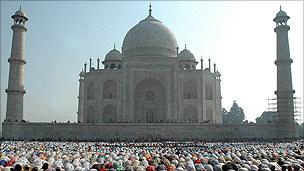What makes a place worthy of World Heritage status?
- Published
Ancient ruins in a subway: Could they get world heritage status?
There are 38 British sites looking for World Heritage status. So should a ruined 12th Century priory discovered in south London be ranked alongside the Taj Mahal and Great Wall of China?
In most ways it is an underpass like any other. There are discarded shopping trolleys, the sound of cars overhead, and the less than fragrant smell of urine.
The idea that anyone would mark this underpass in south London's Collier's Wood as a place of worldwide significance would merit a smirk at first glance.
But behind an inconspicuous black door, near the entrance of the alley, lies a completely different world.
"So many people walk past it every day", says John Hawks, the guide. "So many people see it every day but they do not know that such an extraordinary piece of history is right beside them."
As his key turns and the door swings open, we are transported to a completely different time. Stone foundations mark out what was once the chapter house of Merton Priory.
The dim lighting, and the immaculately preserved stone coffins, which survived far longer than their occupants, give the room a sense of eeriness, but also warmth. Looking at the remains of what were once the beautifully carved windows of the abbey, it is easy to imagine how grand this place would have been once.
But it is also very surreal. Looking up and seeing the road a few metres above, or hearing the clatter of shopping trolleys go by is a strange juxtaposition of old and new.
Accidental discovery
"Four hundred years ago everyone would have known what Merton Priory was", says Mr Hawks, a member of the Merton Priory Trust, which was formed to help promote the site.

Lincoln, which has one of the UK's most famous cathedrals, hopes to get World Heritage status
"It was an enormous abbey with a huge church as big as Westminster Abbey. It was about 10 miles out of London and many of the kings of England - Henry III, Henry VI - liked to come out here."
Merton Priory was built in the 12th century, he explains, and the site holds particular historical significance because it was here in the room that the statutes of Merton - which formed the basis of English law - were drawn up.
During the abolition of the monasteries under Henry VIII, the priory was knocked down. For centuries it lay in ruins before it got covered up completely. It was only 20 years ago, when a supermarket was about to be built in the area, that the ruins were discovered following an excavation of the site.
Although hundreds of shoppers pass by and countless cars drive over it, it is rarely open to visitors. The Merton Priory Trust hopes one day to create a visitors centre and a museum here.
Merton Priory is one of 38 places in the UK currently being considered, external by the Department of Culture, Media and Sport to go forward as British candidates for World Heritage status in 2011.
Others on the shortlist include the seaside resort of Blackpool, Jodrell Bank Observatory and the City of Lincoln.
Ministers will spend the next few months deciding aselect few be submitted to the body which awards World Heritage Status, Unesco, the United Nations Educational, Scientific and Cultural organization. Last week it unveiled the latest 21 sites, external to be added to the list.
A site worth of World Heritage status should have "outstanding universal value for humanity", from the point of view of history, art or science.
"All countries have sites of local or national interest, which are quite justifiably a source of national pride," says the World Heritage website. "The World Heritage list reflects the wealth and diversity of the Earth's cultural and natural heritage."
Bob Bewley from the Heritage Lottery Fund, which uses National Lottery money to award grants to help with the upkeep of British sites of interest, says it is about showing relevance beyond one community or area.

Already special: the Taj Mahal
"It's showing that something which was happening in a small part of whichever country it might be, had significance on the world stage."
Mr Bewley says that what we conceive as heritage is evolving from simply ancient buildings and historic monuments. "Now it's much more about people and places, it's about what people value as important."
Well known examples of World Heritage sites include the Taj Mahal, the Statue of Liberty and Stonehenge. But there are many you may not have heard of, like Blaenavon Industrial Landscape in Wales, which achieved world heritage status in 2000.
The Blaenavon Landscape covers an area of 33 square kilometres and includes the site of an 18th century ironworks.
Emyr Morgan, the centre manager, says winning the accolade does not mean you are given any money directly from Unesco, but the title itself did help the centre attract visitors and funding.
"It's given local people an enhanced sense of pride in terms of the history of the area," he says.
"Previously people were proud of its history but economically, the area has been in decline since the start of the demise of the deep mining coal industry."
Mr Morgan says that the local council has also been able to use World Heritage status as a means of regenerating the area, by attracting investment it might otherwise not have got.
It has also helped to drive visitor numbers up. Big Pit, a coal mining museum, now attracts 177,000 visitors a year, and Mr Morgan says he has the world heritage label to thank.